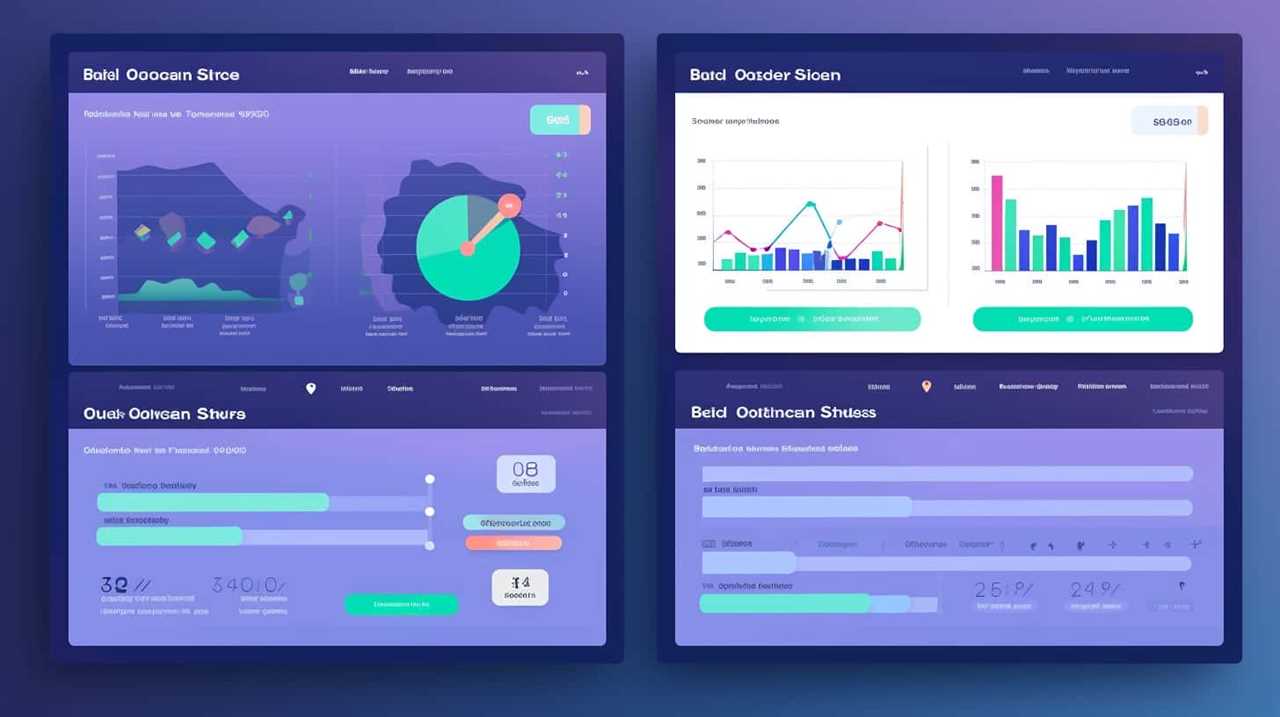Have you ever encountered the phrase ‘Content is king’? Curious about why it dominates in the realm of user experience?
In this article, we’ll explore the vital role of content strategy in creating a seamless and satisfying user journey.
From aligning content with user expectations to optimizing for accessibility and voice search, we’ll uncover the key ingredients that deliver a liberating and user-focused experience.
Get ready to revolutionize your approach to content and elevate your user experience to new heights.

Key Takeaways
- Content strategy plays a crucial role in enhancing user experience.
- Aligning content with user expectations enhances user satisfaction.
- Meeting user’s needs is crucial for creating a successful user experience.
- Creating engaging and relevant content is essential for a positive user experience.
The Importance of Content Strategy
In our experience, content strategy plays a crucial role in enhancing user experience. When it comes to aligning user expectations and creating a user-centered design, content strategy is the key.
By strategically planning and organizing content, we ensure that it meets the needs and expectations of our users. This means delivering relevant and valuable information in a way that’s easy to understand and navigate.
A well-executed content strategy not only helps users find what they need but also keeps them engaged and satisfied. It ensures that the right content is presented in the right place and at the right time, making the user experience seamless and enjoyable.
In short, content strategy is essential for creating an effective and user-friendly experience that liberates users from frustration and confusion.

Aligning Content With User Expectations
We understand the importance of aligning content with user expectations.
By creating user-centered content, we can ensure that it meets the needs and preferences of our users.
This not only enhances user satisfaction but also improves the overall user experience.
User-Centered Content Creation
Aligning content with user expectations is crucial for creating a user-centered content strategy. By understanding and meeting the needs of our users, we can optimize our content to deliver a seamless and satisfying user experience. User-centered content creation involves crafting content that is tailored to the preferences, interests, and goals of our target audience. This ensures that our content resonates with users, captures their attention, and provides them with the information they seek. To achieve this, we must conduct thorough research, gather user feedback, and continuously refine our content to align with user expectations. By doing so, we can create a content strategy that not only meets the needs of our users but also exceeds their expectations, resulting in increased engagement and satisfaction. Now let’s explore how we can meet the specific needs of our users in the next section.

| Benefits of User-Centered Content Creation | How it Helps Users |
|---|---|
| Increases user engagement | Provides relevant and valuable information |
| Enhances user satisfaction | Meets users’ specific needs and preferences |
| Improves user retention | Creates a seamless and enjoyable user experience |
Next, we will discuss how to meet the needs of our users in more detail.
Meeting User’s Needs
Meeting user’s expectations is crucial for creating a successful user experience. To achieve this, we need to adopt a user-centered design approach that puts the users at the heart of our content strategy.
Here are four key ways to meet the user’s needs:
- Conduct user research: By understanding our target audience, their preferences, and pain points, we can create content that resonates with them.
- Develop user personas: Personas help us visualize our users and their goals, enabling us to tailor our content to their specific needs.
- Create relevant and valuable content: The content we produce should address the user’s needs, provide solutions, and deliver value.
- Continuously evaluate and improve: Regularly gathering feedback and analyzing user behavior allows us to refine our content strategy and ensure it continues to meet user expectations.
Enhancing User Satisfaction
To what extent does aligning our content with user expectations contribute to enhancing user satisfaction? When it comes to user engagement and content optimization, aligning our content with user expectations is crucial for enhancing user satisfaction. By understanding what our users want and expect from our content, we can deliver a more personalized and relevant experience that meets their needs. This not only increases user engagement but also helps to create a sense of trust and loyalty. To illustrate the importance of aligning content with user expectations, consider the following table:

| User Expectations | Content Delivery | User Satisfaction |
|---|---|---|
| Relevant | Timely | High |
| Clear | Consistent | High |
| Valuable | Accessible | High |
As we can see, when we align our content with user expectations, we can significantly enhance user satisfaction. This sets the stage for creating engaging and relevant content that will be discussed in the next section.
Creating Engaging and Relevant Content
To create engaging and relevant content, we need to target specific audience demographics and optimize our content for SEO.
By understanding who our target audience is, we can tailor our content to their interests, needs, and preferences, making it more engaging and compelling.
Additionally, optimizing our content for SEO ensures that it’s easily discoverable and ranks higher in search engine results, increasing its relevance and visibility to our target audience.

Targeting Specific Audience Demographics
By tailoring content to meet the needs and interests of specific audience demographics, we can create engaging and relevant material that enhances the user experience. To effectively target different generations and understand cultural preferences, consider the following strategies:
- Conduct thorough research: Gain insights into the demographics you’re targeting by conducting surveys, interviews, and analyzing data. This will help you understand their preferences, values, and behaviors.
- Create personalized messaging: Craft content that speaks directly to the specific audience you’re targeting. Use language, visuals, and references that resonate with their unique experiences and interests.
- Utilize segmentation: Divide your audience into smaller segments based on factors such as age, location, or interests. This allows you to create content that’s even more tailored and relevant to each group.
- Continuously analyze and optimize: Regularly monitor and analyze the performance of your content. Use data and feedback to refine your strategies and improve the user experience over time.
Optimizing Content for SEO
We continue to enhance the user experience by optimizing content for SEO, creating engaging and relevant material that drives organic traffic to our website.
SEO optimization is crucial in today’s digital landscape, as it helps our website rank higher in search engine results pages (SERPs) and increases our visibility to potential users.
To achieve this, we conduct thorough keyword research to identify the phrases and terms our target audience is searching for. By incorporating these keywords strategically into our content, we not only improve our website’s search engine rankings but also ensure that our material is tailored to meet the needs and interests of our users.

This approach not only boosts our organic traffic but also enhances the overall user experience, as they can easily find the information they’re looking for.
Understanding User Intent for Better UX
One key aspect of achieving better user experience is understanding the various intents users have when interacting with content. By comprehending user intent, we can tailor our content to meet their needs, resulting in improved engagement and satisfaction.
Here are four key points to consider:
- Research user behavior: Conduct thorough research to understand how users engage with content. Analyze their actions, preferences, and motivations to gain insights into their intent.
- Identify user goals: Determine the specific goals users have when interacting with your content. Are they seeking information, looking to make a purchase, or seeking entertainment? Understanding their goals helps in creating relevant and valuable content.
- Provide personalized experiences: Tailor your content to match different user intents. By personalizing the user experience, you can address their specific needs and deliver content that resonates with them.
- Continuously analyze and adapt: Monitor user behavior and engagement metrics to gain insights into their intent. Use this data to refine your content strategy and optimize the user experience over time.
Optimizing Content for Accessibility
When it comes to optimizing content for accessibility, there are several key points to consider.

First, inclusive content design is crucial in ensuring that all users can access and understand the information provided.
Second, adhering to web accessibility guidelines helps to create a more user-friendly experience for individuals with disabilities.
Lastly, a well-structured content layout enhances readability and comprehension for all users.
Inclusive Content Design
Optimizing content for accessibility is crucial in ensuring an inclusive user experience. To create content that’s accessible to all users, it’s essential to follow inclusive language and accessibility guidelines. Here are four key considerations for designing inclusive content:

- Use clear and concise language: Avoid jargon, acronyms, and complex terms that may exclude or confuse users. Use plain language that’s easy to understand.
- Provide alternative formats: Offer content in multiple formats, such as text, audio, and video, to accommodate different user preferences and accessibility needs.
- Use descriptive headings and captions: Clearly label sections and provide descriptive captions for images and multimedia content. This helps users who rely on screen readers or have visual impairments.
- Ensure proper color contrast: Use colors with sufficient contrast to make text and visual elements easily readable for users with low vision or color blindness.
Web Accessibility Guidelines
To ensure an inclusive user experience, it’s important to adhere to web accessibility guidelines for optimizing content accessibility. Web accessibility compliance ensures that individuals with disabilities can access and interact with web content effectively. Inclusive design goes beyond mere compliance and aims to create an inclusive and equal online experience for all users.
Web accessibility guidelines provide a set of standards and best practices to follow when designing and creating web content. These guidelines cover various aspects such as text alternatives for non-text content, keyboard accessibility, color contrast, and providing clear and consistent navigation. By following these guidelines, we can ensure that our content is accessible to all users, regardless of their abilities.
Optimizing content for accessibility not only enhances the user experience for individuals with disabilities but also benefits all users. It improves overall usability, increases search engine visibility, and promotes a more inclusive and diverse online environment.
User-Friendly Content Structure
By following web accessibility guidelines and incorporating inclusive design principles, we can create a user-friendly content structure that optimizes accessibility for all users.

Here are four key aspects to consider when organizing content for improved accessibility and user engagement:
- Clear and concise headings: Use descriptive headings that accurately summarize the content of each section. This allows users to quickly navigate and understand the structure of the page.
- Logical content organization: Arrange content in a logical and sequential manner, following a clear hierarchy. This helps users easily locate information and follow the flow of the content.
- Use of lists and bullet points: Break down complex information into digestible chunks by using numbered lists or bullet points. This improves readability and comprehension for all users, including those with cognitive disabilities.
- Consistent formatting and styling: Maintain consistency in font sizes, colors, and formatting throughout the content. This ensures that users can easily distinguish different elements and navigate the page smoothly.
The Role of Visual Content in UX
Using visual content enhances our user experience by engaging and captivating our audience. Visual content design and visual storytelling are powerful tools that can greatly impact the overall user experience. By incorporating visual elements such as images, videos, infographics, and illustrations, we can effectively convey information and evoke emotions.
To illustrate the importance of visual content in UX, let’s take a look at the following table:
| Visual Content | Benefits |
|---|---|
| Images | Enhances understanding |
| Videos | Provides dynamic experience |
| Infographics | Presents complex data |
| Illustrations | Adds personality to the content |
By utilizing visual content strategically, we can make our content more visually appealing, easier to comprehend, and memorable. This can lead to higher engagement, increased time spent on our website, and ultimately, better user satisfaction.

In the next section, we will explore the significance of incorporating user feedback into our content strategy and how it contributes to an improved user experience.
Incorporating User Feedback Into Content Strategy
Incorporation of user feedback enhances the effectiveness of our content strategy for user experience. By actively seeking and incorporating user feedback into our content strategy, we can continuously improve the user experience and meet their needs and expectations more effectively.
Here are four ways in which incorporating user feedback can contribute to content improvement:
- Identifying pain points: User feedback helps us identify areas of our content that may be causing confusion or frustration, allowing us to make necessary adjustments.
- Understanding user preferences: Feedback provides valuable insights into what users find appealing and engaging, enabling us to tailor our content to their preferences.
- Enhancing relevance: User feedback helps us understand the specific needs and interests of our audience, allowing us to create more relevant and targeted content.
- Increasing user satisfaction: By incorporating user feedback, we can address their concerns and suggestions, leading to a more satisfying user experience.
By incorporating user feedback into our content strategy, we can continuously improve and provide a better user experience.

Now, let’s explore the next topic of personalization for enhanced user experience.
Personalization for Enhanced User Experience
To enhance the user experience, we can achieve personalization by tailoring content to individual preferences and needs. Personalization techniques play a crucial role in creating a user-centric design that liberates users from generic and impersonal experiences.
By utilizing data-driven insights, we can understand user behavior, interests, and context to deliver personalized content that resonates with each user. This can be done through dynamic content recommendations, personalized product suggestions, or customized messaging based on user preferences.
User-centric design ensures that users feel seen, understood, and valued, resulting in increased engagement, satisfaction, and loyalty. By implementing personalization techniques, we can create a more meaningful and relevant user experience that empowers users to find what they need effortlessly, fostering a sense of connection and trust with the brand.

Ensuring Consistency Across Content Channels
For a seamless user experience, consistency must be maintained across all content channels. This ensures that users receive a unified and coherent message, regardless of the channel they engage with.
To achieve content consistency and cross channel coordination, consider the following:
- Establish brand guidelines: Define clear guidelines for tone, voice, and visual elements to maintain a consistent brand experience across all channels.
- Coordinate content creation: Ensure that content creators collaborate and align their efforts to avoid conflicting messages or duplicate content.
- Use a centralized content management system: Implement a system that allows for easy content management and distribution across multiple channels.
- Regularly audit content: Conduct regular audits to identify inconsistencies and make necessary updates to maintain a consistent user experience.
Using Data to Drive Content Decisions
To make informed content decisions, we use data to drive our strategy. Data-driven decision making is essential for effective content optimization. By analyzing various data points, we gain insights into user behavior, preferences, and needs. With this information, we can create content that resonates with our audience and meets their expectations.
Here is a table that highlights the types of data we utilize and how they inform our content decisions:

| Data Type | Purpose | Examples |
|---|---|---|
| User analytics | Understand user behavior and preferences | Page views, bounce rate |
| Keyword research | Identify popular topics and search terms | Search volume, competition |
| A/B testing | Test different content variations and measure effectiveness | Click-through rate, conversion rate |
Building Trust Through Transparent Content
When it comes to building trust with users, authenticity is key. By being genuine and honest in our content, we can enhance our credibility and establish a strong rapport with our audience.
Transparency plays a crucial role in fostering user loyalty, as it allows users to feel confident and informed in their interactions with our brand.
Authenticity Builds Trust
We believe that authenticity builds trust by creating transparent content. When users encounter content that feels genuine and honest, they’re more likely to trust the information presented to them.
Here are four reasons why authenticity is crucial for building user trust:

- Establishes credibility: Authentic content shows that the organization is trustworthy and knowledgeable in their field.
- Enhances user engagement: Users are more likely to engage with content that feels authentic, leading to longer sessions and increased conversions.
- Fosters emotional connection: Authenticity allows users to connect on a deeper level, creating a sense of loyalty and advocacy.
- Encourages user feedback: When users feel that content is authentic, they’re more likely to provide feedback, leading to improvements and further trust-building.
By prioritizing authenticity in content strategy, organizations can establish credibility, engage users, foster emotional connections, and encourage valuable feedback.
Now, let’s explore how honesty enhances credibility in the next section.
Honesty Enhances Credibility
One key aspect of building trust through transparent content is the honesty it conveys. When we’re honest with our audience, we create a sense of credibility that fosters loyalty. By being transparent about our intentions, motives, and the information we provide, we establish a strong foundation of trust with our users.
Honesty in content strategy means delivering accurate and reliable information, without any hidden agendas or biases. It means admitting mistakes and taking responsibility for them. When we’re honest, our users feel valued and respected, which in turn strengthens their trust in us.

This trust becomes the cornerstone of a loyal user base that believes in our brand and continues to engage with our content. As we dive deeper into the topic, we’ll explore how transparency fosters user loyalty.
Transparency Fosters User Loyalty
To foster user loyalty, transparency in content strategy plays a crucial role in building trust and credibility. Transparency refers to being open, honest, and upfront with users, providing them with clear and authentic information. When content is transparent, it creates a sense of trust and reliability, which in turn fosters user loyalty.
Here are four ways in which transparency impacts user loyalty:
- Establishes credibility: Transparent content helps users perceive a brand as trustworthy and reliable, leading to increased loyalty.
- Builds stronger relationships: Openness and honesty in content create a stronger connection and rapport with users, enhancing loyalty.
- Encourages user participation: Transparent content invites users to engage and contribute, fostering a sense of ownership and loyalty.
- Reduces uncertainty: Clear and transparent information alleviates user concerns and doubts, strengthening loyalty.
By prioritizing transparency in content strategy, brands can cultivate user trust and loyalty, creating a positive user experience.

Now, let’s delve into the next section, which explores the impact of voice search on user experience.
Voice Search and Its Impact on User Experience
Voice search significantly impacts user experience. With the rise of voice assistants like Siri, Alexa, and Google Assistant, more users are relying on voice search to find information, make purchases, and complete tasks.
This shift in search behavior has a direct impact on SEO. Traditional keyword-based SEO strategies may not be as effective in optimizing for voice search. Instead, content creators need to focus on conversational and natural language phrases that align with how users speak. This means incorporating long-tail keywords and answering specific questions in their content.
Furthermore, voice search requires faster and more accurate results, as users expect instant responses. Therefore, optimizing website speed and ensuring mobile-friendliness are crucial for delivering a seamless voice search experience.

Mobile-Friendly Content for Seamless UX
Creating mobile-friendly content is essential for providing a seamless user experience. In today’s mobile-driven world, it’s imperative that businesses prioritize mobile first design and responsive web design to cater to the needs of their users. Here are four reasons why mobile-friendly content is crucial for a seamless user experience:
- Improved accessibility: Mobile-friendly content ensures that users can access and navigate your website easily on their mobile devices, regardless of the screen size or resolution.
- Faster load times: Optimizing content for mobile devices helps reduce load times, ensuring that users can quickly access the information they need.
- Enhanced user engagement: Mobile-friendly content allows users to interact with your website effortlessly, leading to increased engagement and a more enjoyable user experience.
- Higher search rankings: Search engines prioritize mobile-friendly websites, making it essential to optimize your content for mobile devices to improve your search rankings.
By prioritizing mobile-friendly content, businesses can provide a seamless user experience and stay ahead in the competitive digital landscape.
In the following section, we’ll explore the importance of content hierarchy and navigation for UX.
Content Hierarchy and Navigation for UX
Our content strategy focuses on implementing an effective hierarchy and navigation system to enhance the user experience. A well-structured content hierarchy ensures that users can easily find and access the information they need, leading to increased user engagement. By organizing content in a logical and intuitive manner, we empower users to navigate through our website or application effortlessly, saving them time and frustration.

To achieve this, we utilize a content structure that is user-focused and strategic. This involves categorizing information into meaningful sections and sub-sections, allowing users to quickly locate what they are looking for. Additionally, we implement a clear and intuitive navigation system that enables users to move seamlessly between different pages or sections.
To illustrate the importance of content hierarchy and navigation, consider the following table:
| Level 1 | Level 2 | Level 3 |
|---|---|---|
| About | Company | History |
| Team | ||
| Values | ||
| Products | ||
| Category A | Product 1 | |
| Product 2 | ||
| Category B | Product 3 | |
| Contact |
Measuring Content Success With Analytics
To measure the success of our content, we use analytics to gather valuable insights and make data-driven decisions for enhancing user experience. Here are four key ways we measure content engagement and analyze user behavior:
- Tracking Page Views: By monitoring the number of views for each page, we can identify which content is attracting the most attention and resonating with our audience.
- Analyzing Time on Page: Understanding how long users spend on a page helps us gauge their level of interest and whether the content is holding their attention.
- Monitoring Click-through Rates: By tracking the number of clicks on links within our content, we can identify which calls to action are most effective in driving user engagement.
- Assessing Bounce Rates: Bounce rates indicate the percentage of users who leave a page without taking any further action. By analyzing bounce rates, we can identify areas where our content may be falling short and make improvements to keep users engaged.
Frequently Asked Questions
How Can Content Strategy Impact the Overall User Experience?
Content planning is essential for effective UX design. By strategically organizing and structuring content, we can enhance the overall user experience. It allows us to deliver relevant, valuable, and user-centric information, empowering individuals to navigate and engage with our digital products.

What Are Some Best Practices for Aligning Content With User Expectations?
Aligning content with user expectations is crucial for effective user engagement. It’s like fitting puzzle pieces together – when content is relevant and meets their needs, users feel liberated and connected, resulting in a positive user experience.
How Can User Intent Be Understood and Utilized to Improve Ux?
Understanding user intent and analyzing user behavior are crucial for improving UX. By utilizing these insights, we can create a content strategy that aligns with user expectations, resulting in a more satisfying and liberating user experience.
What Are Some Key Considerations for Optimizing Content for Accessibility?
When optimizing content for accessibility, we consider content structure and inclusive design. It’s crucial to ensure that all users, regardless of ability, can access and engage with our content effectively.
How Can User Feedback Be Incorporated Into Content Strategy to Enhance the User Experience?
Incorporating user feedback into our content strategy is essential for a user-centric approach and enhancing the user experience. By listening to their needs and preferences, we can create content that truly resonates and delivers value.

Conclusion
In conclusion, a strong content strategy is essential for delivering a seamless and satisfying user experience.
Just like a well-organized library, where books are carefully categorized and easy to find, a well-planned content strategy ensures that users can easily navigate and access the information they need.
By aligning content with user expectations, creating engaging and relevant content, and optimizing for accessibility, businesses can enhance user satisfaction and drive better results.
Remember, a well-executed content strategy is the key to unlocking a successful user experience.











